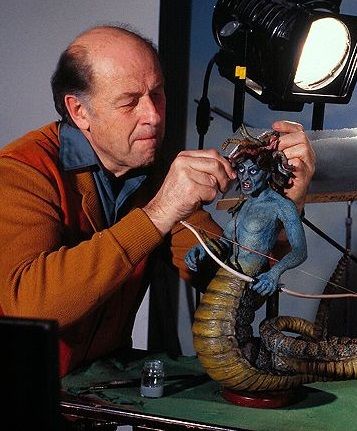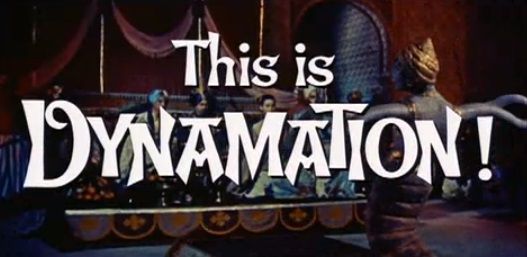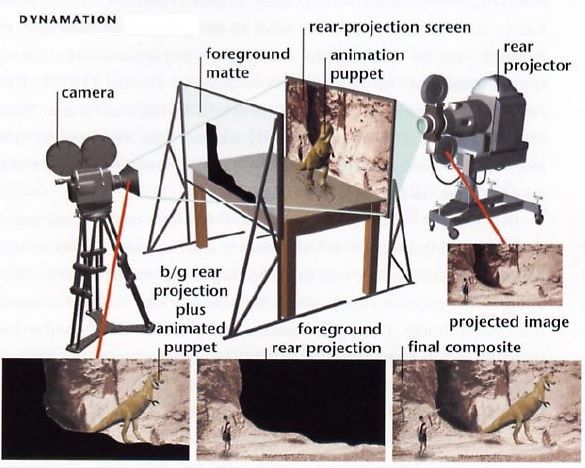Wolffian Classics Movies Digest is currently hosting a blogathon in tribute to Ray Harryhausen, the stop-motion animator extraordinaire behind such fantasmagorical creatures as the fighting skeletons, the cyclops, Medusa, Kraken, and the beast from 20,000 fanthoms in such classics as Jason and the Argonauts ( 1963 ), The 7th Voyage of Sinbad ( 1958 ), and Clash of the Titans ( 1981 ).
Prior to Harryhausen's development of this technique most animation was created for sequences that did not require "live" actor interaction within the scene. For instance, in an adventure film a group of archaeologists may come across a dinosaur grazing on grass in the distance. The director of the movie would film the actors expression of surprise upon seeing the dinosaur and an animator would film the stop-motion sequence of the dinosaur but when completed these scenes would remain separate...actors in one scene, animation in another. However, with the split-screen process, viewers were able to see the actors directly interacting with the animation..e.g a dinosaur with a man struggling to get free from his grasp.
In three-dimensional stop-motion animation, an object, or a poseable model, is photographed one frame at a time using a traditional film camera. In between each frame the animator moves the arms or legs of the model a fraction of an inch before photographing the object again. When these still shots are run through a projector the rapid succession of images creates the illusion of movement. A standard 35mm film projector runs the film at 24 frames per second, and so 24 separate photographed frames have to be taken to make each second of animation on screen. Hence, a 2-minute sequence of a giant cyclops eyeing a tasty morsel for dinner would take 2,880 separate frames to compose. Quite a time-consuming task!
Stop-motion animation can be traced back to the beginning of movie-making, in the late 1800s. Some of the earliest animated films include Vitagraph's The Humpty Dumpty Circus ( 1897 ) by Albert E. Smith and J. Stuart Blackton, featuring a circus of acrobats and animals coming to life, and The Haunted Hotel by J. Stuart Blackton ( 1907 ).
Willis O'Brien was the resounding king of animation during the early days of talking pictures. He brought to life the prehistoric creatures of yor in First National Pictures adaption of Arthur Conan Doyle's The Lost World ( 1925 ) and later, in one of the most iconic films of the century, King Kong ( 1933 ), where he created a creature so lifelike in appearance and emotion that many viewers were brought to tears at his demise at the end of the film.
It was Willis O'Brien's work on King Kong that instilled in Ray Harryhausen the desire to make stop-motion animation his career. The Eighth Wonder of the World inspired the young 14-year-old Ray to attempt creating his own model Kong, which led to his discovery of the stop-motion animation process.
Under O'Brien's tutelage, Harryhausen learned the filmmaker's craft from the ground up and by 1948 was working alongside O'Brien on his first feature film, Mighty Joe Young ( 1948 ). O'Brien had utilized the multi-dimensional process of interacting animation with the actors through the means of sandwiching his models between two glass paintings, one of which was painted foreground, and shooting "through" them with the camera.
It was while working solo on his second feature film ,The Beast from 20,000 Fanthoms, that Harryhausen realized what a tiresome and time-consuming process painting foreground could be and knew that it would never work for that particular film due to the low budget the production had. He had been experimenting with using mattes as far back as 1938 to create a "split-screen" and so on The Beast from 20,000 Fanthoms he put those tests to use.
The split-screen was a simple process that used mattes to block out portions of the film. Since film only develops from the light that escapes through the eye of a camera, any portion that is blackened out remains undeveloped. If the film is rewound the portion that was blackened can then be used again. This technique was used as far back as the early 1900s.
Dynamation however, used a model in between the matte and the background image to create a three layered image. The first step in the Dynamation process was to plan out in detail the movements the model, or creature, was to make and then to film the live-action scene with the actors and usually a stick or stand-in crew members to represent the movements and position of the creature.
Although it sounds like a very tiresome process, it was actually much easier to utilize mattes then to build and film miniature sets for the models to move in.
In 1957, Charles Schneer, the producer of many of Harryhausen's films during the late 50s and 1960s, dubbed this split-screen technique Dynamation. He was sitting in his Buick one day while waiting for traffic and noticed the Dynaflow logo written on the dashboard...he thought the prefix dyna would be the perfect marketing term for Harryhausen's animation process.
In 1957, Charles Schneer, the producer of many of Harryhausen's films during the late 50s and 1960s, dubbed this split-screen technique Dynamation. He was sitting in his Buick one day while waiting for traffic and noticed the Dynaflow logo written on the dashboard...he thought the prefix dyna would be the perfect marketing term for Harryhausen's animation process.
Harryhausen used Dynamation in It Came from Beneath the Sea ( 1954 ), Earth Versus the Flying Saucers ( 1956 ), The Animal World ( 1956 ) and 20 Million Miles to Earth ( 1957 ) but it was not until The 7th Voyage of Sinbad ( 1958 ) that it was exploited as a merchandising feature.
"Dynamation will be brought to the screen for the first time in COLOR!"
In the short trailer This is Dynamation! ( 1957 ) used to promote The 7th Voyage of Sinbad, the narrator announces the glorious wonders of the technique and how "anything that the mind can conceive can now be brought to the screen".
Dynamation was utilized on all of the Ray Harryhausen films up until his final feature motion picture, Clash of the Titans in 1981. Today, most special effects are created using computer graphic programs ( CGI ) but somehow, in spite of the amazing realism provided by digital graphics there is something very unique, very alive, about Harryhausen's technique. Perhaps the creatures we see created by computer effects have lost their awe because we know the secret behind their existence The mysterious process of Dynamation was kept from the public during the release of many of his biggest films... and this was one more element that added to the magic of the Harryhausen pictures.
This post is our contribution to the Ray Harryhausen Blogathon being hosted by Wolffian Classics Movies Digest. It was originally published here on Silver Scenes in June, 2013. Click this link to read more posts about Harryhausen, his work, and his films. Enjoy!
This post is our contribution to the Ray Harryhausen Blogathon being hosted by Wolffian Classics Movies Digest. It was originally published here on Silver Scenes in June, 2013. Click this link to read more posts about Harryhausen, his work, and his films. Enjoy!








wonderful post about Ray Harryhausen and the Creation of Dynamation,i will gladly put it up tomorrow.
ReplyDeleteExcellent post! I recall Dynamation was also called SuperDynaMation and Dynarama later on, but both were the same technique, just re-branded.
ReplyDeleteYou're right, Greg, I had forgotten to mention that in my post. Just yesterday I was looking at the Golden Voyage of Sinbad poster and wondered whether Dynarama was not Dynamation re-named. Glad you enjoyed the article!
DeleteI just put it live on my blog for Ray Harryhausen blogathon
ReplyDeleteThanks Joey!
DeleteI love how Harryhausen always pushed that old envelope and constantly impressed his audience. Fascinating stuff.
ReplyDelete"Release the Kraken!" I had forgotten (briefly) about Clash of the Titans... Spent so much time watching and re-watching Sinbad, it became the only movies he made in my mind for a minute...
ReplyDeleteA great history and description of Harryhausen's unique contribution to special effects. I enjoy his films so much more than the current CG-drive ones. Somehow, his best effects seems more alive. By the way, I heartily recommend Harryhausen's terrific book about Dynamation and his movies. It's called THE FILM FANTASY SCRAPBOOK.
ReplyDeleteThanks for such a clear explanation of how Dynamation worked! I had read briefly about it before, but did not understand the process properly, but your post really helped me understand fully.
ReplyDelete